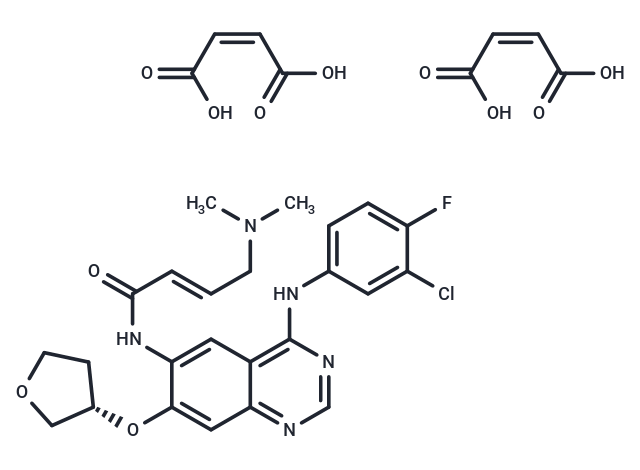Shopping Cart
- Remove All
 Your shopping cart is currently empty
Your shopping cart is currently empty

Afatinib Dimaleate (BIBW 2992MA2) is an orally bioavailable anilino-quinazoline derivative and inhibitor of the receptor tyrosine kinase (RTK) epidermal growth factor receptor (ErbB; EGFR) family, with antineoplastic activity.

| Pack Size | Price | Availability | Quantity |
|---|---|---|---|
| 5 mg | $34 | In Stock | |
| 10 mg | $54 | In Stock | |
| 25 mg | $79 | In Stock | |
| 50 mg | $109 | In Stock | |
| 100 mg | $143 | In Stock | |
| 200 mg | $198 | In Stock | |
| 500 mg | $329 | In Stock | |
| 1 g | $492 | In Stock | |
| 1 mL x 10 mM (in DMSO) | $60 | In Stock |
| Description | Afatinib Dimaleate (BIBW 2992MA2) is an orally bioavailable anilino-quinazoline derivative and inhibitor of the receptor tyrosine kinase (RTK) epidermal growth factor receptor (ErbB; EGFR) family, with antineoplastic activity. |
| Targets&IC50 | HER2:14 nM, EGFR (L858R/T790M):10 nM, EGFR (L858R):0.4 nM, EGFR (WT):0.5 nM |
| In vitro | In the MDA-MB-453 transplantation tumor model, oral administration of Afatinib (20 mg/kg), which down-regulated the phosphorylation levels of EGFR and AKT, induced tumor regression. In the NCI-N87 transplantation model of HER2-positive gastric cancer, oral administration of Afatinib (25 mg/kg) was able to eliminate tumors. In A7, A431, FaDu, UT-SCC-14 and UT-SCC-15 transplantation tumor models, oral administration of Afatinib (30 mg/kg) inhibited tumor growth. |
| In vivo | In lung cancer cell lines expressing wild-type (H1666) or L858R/T790M (NCI-H1975) EGFR, Afatinib inhibited cell growth more effectively. In NSCLC cell lines expressing HER2 776insV (NCI-H1781) or EGFR E746_A750del (HCC827), Afatinib was more effective in inhibiting cell growth. |
| Kinase Assay | In vitro kinase activity assay: EGFR kinase: Each 100 μL enzyme reaction contained 10 μL of inhibitor in 50% Me2SO, 20 μL of substrate solution (200 mM HEPES pH 7.4, 50 mM Mg-acetate, 2.5 mg/mL poly (EY), 5 μg/mL bio-pEY) and 20 μL enzyme preparation. The enzymatic reaction is started by addition of 50 μL of a 100 μM ATP solution made in 10 mM MgCl2. Assays are carried out at room temperature for 30 min and terminated by the addition of 50 μL of stop solution (250 mM EDTA in 20 mM HEPES pH 7.4). 100 μL are transferred to a streptavidin coated microtiterplate, after an incubation time of 60 min at room temperature the plate is washed with 200 μL of wash solution (50 mM Tris, 0.05% Tween20). A 100 μL aliquot of a HRPO- labeled anti-PY antibody (PY20H Anti-Ptyr:HRP ) 250 ng/mL are added to the wells. After 60 min of incubation, the plate is washed three times with a 200 μL wash solution. The samples are then developed with a 100μL TMB Peroxidase Solution (A:B= 1:1). The reaction is stopped after 10 min. The plate is transferred to an ELISA reader and extinction is measured at OD450 nM. HER2-IC enzyme: Enzyme activity is assayed in the presence or absence of serial inhibitor dilutions performed in 50 % Me2SO. Each 100 μL reaction contains similar components as described for EGFR kinase assay with addition of 1000 μM Na3VO4. The enzymatic reaction is started by addition of 50μL of 500 μM ATP solution made in 10 mM Mg-acetate. The dilution of the enzyme is set so that incorporation of phosphate into bio-pEY is linear with respect to time and amount of enzyme. The enzyme preparation is diluted in 20 mM HEPES pH 7.4, 130 mM NaCl, 0.05% Triton X-100, 1 mM DTT and 10% glycerol. Assays are carried out at room temperature for 30 min and terminated by the addition of 50 μL of stop solution. Src kinase assays: Each 100 μL reaction contained 10 μL of inhibitor in 50 % Me2SO, 20μL of enzyme preparation, 20 μL of substrate solution supplemented with 1000 μM Na3VO4.The enzymatic reaction is started by addition of 50 μL of a 1000 μM ATP solution made in 10 mM Mg-acetate. BIRK kinase assay: 250 mM Tris pH 7.4, 10 mM DTT, 2.5 mg/mL poly(EY), 5 mg/mL bio-pEY is used as substrate solution and enzymatic reaction is started by addition of 50 μL of a 2 mM ATP solution made in 8 mM MnCl2, 20 mM Mg-acetate. VEGF2 and HGFR kinase assays: Assays are carried out at room temperature for 20 minutes and terminated by the addition of 10 μL of 5 % H3PO4. The precipitate is then trapped onto GF/B filters using a 96 well filter mate universal harvester. After extensive washing the filter plate is dried for 1 h at 50°C, sealed and incorporated radioactivity is determined by scintillation counting using a TopCount? or a Microbeta b counter?. |
| Cell Research | Cytotoxicity is determined using MTT assay. The IC 50 value is de?ned as the drug concentration resulting in 50% cell death. Both the ?tted sigmoidal dose response curve and IC50 are calculated by Bliss method.(Only for Reference) |
| Alias | BIBW2992, BIBW 2992MA2, Afatinib (BIBW2992) Dimaleate, Afatinib |
| Molecular Weight | 718.08 |
| Formula | C32H33ClFN5O11 |
| Cas No. | 850140-73-7 |
| Smiles | OC(=O)\C=C/C(O)=O.OC(=O)\C=C/C(O)=O.CN(C)C\C=C\C(=O)Nc1cc2c(Nc3ccc(F)c(Cl)c3)ncnc2cc1O[C@H]1CCOC1 |
| Relative Density. | no data available |
| Storage | Powder: -20°C for 3 years | In solvent: -80°C for 1 year | Shipping with blue ice. | ||||||||||||||||||||||||||||||
| Solubility Information | H2O: < 1 mg/mL (insoluble or slightly soluble) DMSO: 50 mg/mL (69.63 mM) Ethanol: < 1 mg/mL (insoluble or slightly soluble) | ||||||||||||||||||||||||||||||
Solution Preparation Table | |||||||||||||||||||||||||||||||
DMSO
| |||||||||||||||||||||||||||||||

Copyright © 2015-2024 TargetMol Chemicals Inc. All Rights Reserved.